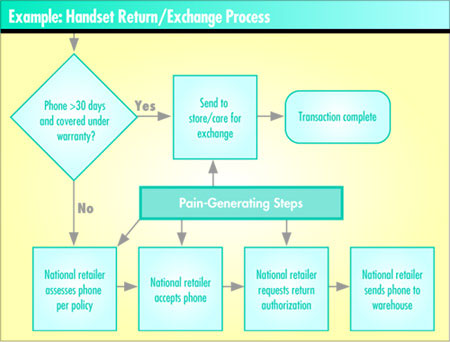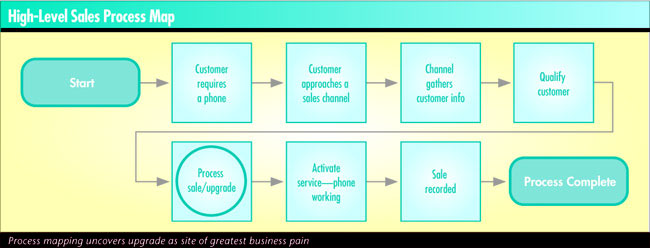
by Zachery Brice
|
If Six Sigma isn’t just for manufacturing anymore,
it isn’t just for remedying defects, either.
The renowned methodology can also be applied proactively
to fulfill a pressing business need. The wireless
telephone industry provides a case in point. Although
the business has grown phenomenally during the past
six years, it’s now maturing. To maintain profitable
growth, it must become increasingly necessary to acquire
high-value customers as cost-effectively as possible.
To maintain its competitive edge, a regional telephone
company decided to slash its cost-per-gross-add of
a new wireless customer.
Through process mapping the entire sales cycle, a
Six Sigma team determined that the greatest opportunity
for reducing CPGA lay in the costs of upgrading and
replacing customers’ malfunctioning handsets,
as illustrated on page XX. The team zeroed in on the
upgrade and exchange process, uncovering key areas
where problems were likely to increase costs in returns
and exchanges (See the figure on page XX).
At this point, the team applied Pareto analysis to
identify process capabilities and develop a program
for improvement. The team broke return/exchanges into
three classes based on whether the return occurred
fewer than 30 days after the sale, more than 30 days
to a year after the sale, and more than a year after
the sale. The information allowed them to pinpoint
improvements in each of these circumstances.
The improvements included working more closely with
the handset manufacturer, working with retailers to
improve their internal processes, insisting on compliance
with a return/exchange policy, automating some key
processes to eliminate errors and reeducating customers
on how best to handle problems with handsets. As a
result of these efforts, the team reduced more than
$236,500 in expenses annually.
|
Since Six Sigma was first developed
at Motorola, refined at AlliedSignal and transformed into
legend at GE under Jack Welch, it has found legions of new
converts in myriad business sectors. Now this successful
quality initiative is revolutionizing not just manufacturing
but also service industries, including outsourcing, financial
services and telecommunications organizations.
Six Sigma--originally designed to perfect manufacturing
processes that were already highly engineered--might seem
ill-suited to service organizations, wherein processes aren’t
engineered at all. But this is precisely why the methodology
has something valuable to offer service organizations. Because
many service businesses (which often suffer from inflated
costs and poor customer service) have never analyzed their
processes, they are ripe with potential for process improvement.
Six Sigma’s wider applicability was first glimpsed
at GE. The company understood that Six Sigma techniques
could be applied to any process that resulted in defects,
whether they be faulty products, financial transactions
or business processes. With this knowledge, GE soon expanded
Six Sigma to its service businesses, GE Financial.
The heart of every service-based business depends on the
opinions, behaviors and decisions of people acting through
work processes. Analyzing and modifying human performance
in these environments is complex. Nevertheless, task-oriented
service organizations including mortgage lenders, wireless
phone providers and call centers have discovered that Six
Sigma brings a process focus to their operations (e.g.,
streamlined mortgage approval procedures, improved customer
service processes and improved customer-problem resolution).
Six Sigma has been particularly successful in the financial
services sector, in which performance management is critical.
Customers expect faster and easier service at every point
of contact--and if they don’t get it, they go elsewhere.
The economic boom of the 1990s strained many lending institutions’
capacity to originate, close and service loans quickly enough
to meet customer demand. As a result, companies attempted
to improve the cycle times of all processes, break bottlenecks,
minimize errors, cut costs, increase capacity and delight
customers. They had discovered that providing more value
per customer transaction--rather than securing more transactions--leads
to market leadership. Simply put, delighting existing customers
can be more important than finding new ones, as this intense
focus on customer satisfaction leads to top-line growth
and drives greater shareholder value.
By using Six Sigma’s define-measure-analyze-improve-control
process, leading financial services organizations have worked
to reach the methodology’s aim of near error-free
performance. Moreover, this goal is relevant to all processes,
from handling customers’ money, to processing payments,
to sending out bills, to closing a loan, to answering the
phone.
The international private banking division of one of the
world’s largest banking and financial services companies
provides an example. The group faced increasing customer
dissatisfaction as a result of inefficiencies in its international
wire-transfer operations. The inefficiencies greatly increased
the bank’s annual wire-processing costs, some of which
the bank passed along to customers through transaction fees--despite
the fact that the bank’s own surveys identify fees
as a key customer concern.
The bank used Six Sigma to redesign its international
wire-transfer process, greatly reducing the errors, customer
callbacks, transfer delays and transfer fees that inconvenienced
customers and contributed to high rates of customer churn.
Transfer cycle time was slashed 46 percent, which, coupled
with an extended cutoff time for making transfers, has all
but eliminated delayed wires. Slashing the cost-per-payment
order by more than 50 percent has also enabled the division
to waive its transaction fees entirely, further improving
customer satisfaction. In addition to helping the bank retain
valued customers, the improvements could save the company
nearly $1 million annually. And perhaps a more important
(albeit less quantifiable) result is that the bank has improved
its reputation in its customers’ eyes.
A leading mortgage banking firm offers another example
of how Six Sigma can drive customer satisfaction and ultimately
increase market share and growth. The bank, whose clientele
includes borrowers disqualified from traditional loan sources,
wanted to improve customer satisfaction and increase investor
confidence. In addition to establishing a customer-relationship
management initiative, the firm introduced Six Sigma into
key business processes by training in-house Six Sigma experts
to lead critical process redesign projects. Once the initiative
was launched, the bank not only addressed customer and investor
issues but also produced significant and unanticipated increases
in revenue and reductions in costs.
The lender improved customer satisfaction and response
time by 350 percent, cutting “abandoned customer call”
rates from 12 to 4 percent and reducing process redundancies
by 66 percent. At the same time, an increase in loan retention
of 20 percent and the elimination of $21 million in risk
exposure boosted investor confidence. Together, these improvements
save the company $5.5 million annually and have generated
additional revenues of $1 million.
Following that solid record of success in financial services,
the next Six Sigma revolution is likely to take place in
the telecommunications industry. Both the telecommunications
equipment and services sectors have been badly battered
in recent years. Total spending on equipment fell by about
15 percent in 2001 and another 20 percent in 2002. Long-haul
optical networks now operate at less than half their capacity.
Until sales of core wire-line equipment pick up, manufacturers
in the United States and Europe also face the challenge
of developing products to deliver data and voice traffic
from long-distance networks to broadband customers in urban
areas. The mobile communications segment is also changing
as exhaustively hyped mobile data services and third-generation
wireless technology arrive.
During the late 1990s, the telecommunications services
sector held fast to the motto, “Build it and they
will come.” After the Telecommunications Act of 1996
passed, the telecom sector rode the high-tech current of
an economic expansion that, in retrospect, appears to have
been built on blind faith. During the five years following
the 1996 legislation, the telecom industry received $1.3
trillion from investors and has since lost more than $1
trillion in market value.
For telecommunications equipment and services, short-
and long-term success depends on excelling in operational
focus, financial discipline and opportunistic growth. Six
Sigma can help with all three. What follow are examples
illustrating highly focused projects that suggest the enormous
potential of applying Six Sigma to the telecommunications
industry:
 Increasing sales force availability for customers in emerging
markets. Relentless competition in telecommunications requires
an account team that can assess customer needs and submit
quotes quickly. Nevertheless, Six Sigma analysis suggests
that salespeople in the emerging market for a telecommunications
provider spend an average of 52 percent of their time in
nonvalue-added activities such as travel, meetings and customer
service issues--despite the fact that the company depends
on increased sales force productivity to weather the economic
downturn and industry turmoil.
Increasing sales force availability for customers in emerging
markets. Relentless competition in telecommunications requires
an account team that can assess customer needs and submit
quotes quickly. Nevertheless, Six Sigma analysis suggests
that salespeople in the emerging market for a telecommunications
provider spend an average of 52 percent of their time in
nonvalue-added activities such as travel, meetings and customer
service issues--despite the fact that the company depends
on increased sales force productivity to weather the economic
downturn and industry turmoil.
Six Sigma analysis uncovers statistically and economically
significant relationships between the time spent on nonvalue-added
activities, the extent of a salesperson’s territory
(whether the salesperson sets his or her own customer appointments
or these are preset), and the amount of time and territory-management
skills required to provide outstanding service.
A company can address all these factors by setting up
a special call center team to set appointments for salespeople
and develop a process for route management that enables
the team to prioritize appointments in the most geographically
efficient way. As a result, salespeople can spend more time
in front of prospective customers, save money on travel
and spend less time on nonvalue-added activities.

 Reducing the sales-to-cash interval. As a private branch
exchange dealer/distributor’s selling model shifts
to resale, the company must forecast and accelerate customers’
payments after installation more accurately in order to
reduce exposure to creditors. The sales-to-cash interval
averages four months, whereas reducing it by only one month
would save $550,000. However, the company’s sales-to-cash
process is complex, with numerous interdependencies that
can cause excessive delay. A Six Sigma team finds that the
longest interval under direct control is the time from installation
to posting the invoice. The average time stands at 18.3
days, costing the company $420,000 annually in delayed revenue.
Reducing the sales-to-cash interval. As a private branch
exchange dealer/distributor’s selling model shifts
to resale, the company must forecast and accelerate customers’
payments after installation more accurately in order to
reduce exposure to creditors. The sales-to-cash interval
averages four months, whereas reducing it by only one month
would save $550,000. However, the company’s sales-to-cash
process is complex, with numerous interdependencies that
can cause excessive delay. A Six Sigma team finds that the
longest interval under direct control is the time from installation
to posting the invoice. The average time stands at 18.3
days, costing the company $420,000 annually in delayed revenue.
Focusing on this critical interval, the team develops
a database to track an order through its entire life cycle,
creates tools for process operators to monitor overdue orders,
modifies the process for more direct operator communication
and develops a means for regular process control review
and discussion. The interval is reduced by 7.5 days, which
results in annual savings of $420,000. In addition to increasing
the accuracy and timeliness of customer billings, improving
forecasting accuracy, and reducing internal costs, the project
leads to modifications in setting customer expectations
and paves the way for an improved collections process.
 Reducing business market collections. A telecommunications
provider focused on generating sales revenue in its business
market performs poorly when it comes to collecting that
revenue. A preliminary analysis by a Six Sigma team determines
that 60 percent of billed revenue, or approximately $25
million, goes 60 days past due every month--jeopardizing
the company’s objective to achieve positive cash flow
by the end of the year.
Reducing business market collections. A telecommunications
provider focused on generating sales revenue in its business
market performs poorly when it comes to collecting that
revenue. A preliminary analysis by a Six Sigma team determines
that 60 percent of billed revenue, or approximately $25
million, goes 60 days past due every month--jeopardizing
the company’s objective to achieve positive cash flow
by the end of the year.
Combining Six Sigma analytical tools and business process
management, the team’s program to reduce defects in
the collections process includes reprioritizing collections
work, assigning collections representatives to strategic
accounts, conducting collections blitzkriegs, stopping the
high turnover in the collections manager position and implementing
a new call strategy. The project reduces by almost 18 percent
the total past due greater than 60 days, increasing revenue
by $2.4 million.
These examples illustrate only a few of the many processes
and functions that Six Sigma in telecommunications can address.
From maintenance, procurement and operations to customer
care, sales cycle time, cost-per-transaction and duplications,
Six Sigma will likely make enormous differences in customer
satisfaction, revenues and costs. And as the methodology
spreads to more of those functions, its benefits will grow
exponentially.
Successfully implementing Six Sigma in the service sector
requires a relentless focus on customers, specifically,
meeting their needs as efficiently as possible. This requires
four critical steps:
1. Define what’s critical to your customers and confirm
that your core processes are aligned to those requirements.
As the term “services” implies, you must understand
your customers’ needs before you can serve them. Find
out what those needs are through surveys, call center data,
focus groups, promotional campaigns--whatever means allow
the voice of the customer to be heard clearly. At the same
time, you must understand the key business issues for your
company and align the voice of the customer with them.
2. Translate customer requirements into measurable characteristics
of your processes. Once you understand customer requirements,
you must fulfill them by measuring your processes’
effectiveness and efficiency. “Effectiveness”
means addressing the problem of defects that your processes
produce; “efficiency” means addressing the time
and money that the processes consume in meeting customer
needs. A high rate of defects, and time and money wasted
in nonvalue-added activities, increases your cost-per-transaction.
The formula for translating customer requirements into measurable
characteristics is simple: “as measured by.”
For example, if on-time delivery is important for your
customer, the metric would typically be “on-time delivery
as measured by the time from the promised date to the date
of actual fulfillment.”
3. Quantify the effect of gaps in your processes in terms
of the cost of poor quality. For example, a mortgage lender
whose customers want fast action on their applications might
find that the process includes a high number of abandoned
calls by customers or long delays in producing quotes, causing
a drop in prospects and numerous inaccurate credit reports.
The Six Sigma methodology includes powerful tools for analyzing
each of those gaps and quantifying the related cost of poor
quality.
4. Prioritize improvement projects. Once you clearly understand
what each process gap costs, you can prioritize improvement
efforts according to what’s most critical to your
company (e.g., customer service, time, money, perceived
value or other criteria). Because improvement in any organization
proceeds project by project, you must ensure that you’re
investing your effort in the right projects in the right
order.
Above all, you must continue to look at your business
through your customers’ eyes. It’s possible--but
pointless--to redesign your internal processes and never
address your customers’ real needs. However, don’t
remake your processes with only the customer in mind. You
must also address your stakeholders’ concerns and
ensure that your customer-pleasing processes also meet the
critical needs of your business. Six Sigma provides a means
for keeping those sometimes competing voices in perfect
harmony.

Zachery Brice is a managing partner at Six Sigma Qualtec
(www.ssqi.com),
a nationwide provider of Six Sigma process improvement training
and certification to large corporations. He has Master Black
Belt and Black Belt certifications, and more than 26 years
of experience. Brice heads up Six Sigma Qualtec’s
newly formed telecommunications practice.
|